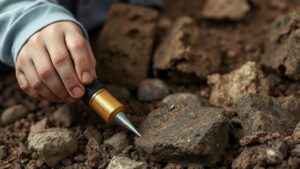Spotting Artifacts in Exposed Rockfall Areas Near Known Habitation Zones
Introduction to Spotting Artifacts in Exposed Rockfall Areas
Understanding the archaeological implications of exposed rockfall areas near known habitation zones is critical for both prehistoric research and modern developmental projects. The interaction between geological processes and human activity often leaves tangible evidence, or artifacts, of past human behavior. Spotting these artifacts requires a blend of keen observation, geological understanding, and archaeological methodology.
The Significance of Rockfall Areas in Archaeology
Rockfall areas, where rock fragments detach and fall from cliffs or mountains, can serve as rich archaeological sites. abrupt exposure of supernatural layers can unearth artifacts that were otherwise buried. These artifacts can inform researchers about human activity, environmental conditions, and cultural practices at specific historical moments.
Case Study: The Neanderthal Sites in Europe
Much of what is understood about Neanderthal life in Europe comes from rockfall sites. At places like the Grotta di Fumane in Italy, archaeologists have discovered layers of sediment containing stone tools and charcoal remnants from fires. e sites illustrate how rockfalls can reveal vital information about the subsistence patterns and environmental adaptations of early humans.
Identifying Habitation Zones
Before searching for artifacts, it is crucial to define what constitutes a known habitation zone. These areas are typically characterized by human-related activities and settlements, often indicated by:
- Presence of artifacts such as tools, pottery, and remnants of dwellings
- Adequate resources like water, fertile land, and raw materials
- Locations near transportation routes or other significant geological features
Geological Indicators of Habitation
Geology plays a pivotal role in identifying these zones. Layers of soil composition can hint at prior human activity. For example, areas enriched with phosphates may suggest the presence of organic materials, such as animal bones or human waste, which are remnants of former habitation and dietary practices.
Techniques for Spotting Artifacts
The process of spotting artifacts in exposed rockfall areas combines visual inspection with advanced techniques. Below are several methods that have proven effective:
- Visual Inspection: This is the foundational step. The archaeologist must look for unusual patterns in the rock, colors that stand out, or irregular shapes that deviate from the natural landscape.
- Ground-Penetrating Radar (GPR): This non-intrusive method transmits radar waves into the ground to detect anomalous structures beneath the surface, helping locate potential artifact deposits hidden under debris.
- Soil Analysis: Collecting soil samples for chemical analysis can provide data on past human activity by detecting remnants of organic matter.
Real-World Applications: Integrating Technology into Excavation
In a recent excavation project in the Blue Ridge Mountains, researchers employed GPR and traditional shoveling techniques simultaneously. use of GPR allowed them to identify a rich deposit of lithic (stone) artifacts that had previously evaded detection. This integration of methods not only saved time but also maximized artifact recovery, showcasing how technology can transform archaeological practice.
Challenges in Artifact Recovery
While spotting artifacts in rockfall areas is promising, several challenges may arise:
- Weather Conditions: Heavy rainfall or snow can obscure artifacts or wash them away, making timing critical for successful excavations.
- Access Issues: Remote rockfall sites may require physical effort to reach; thus, logistical planning is vital.
- Legal Considerations: Navigating land ownership and regulatory permits can complicate archaeological investigations.
Mitigating Challenges through Collaboration
Collaboration with local authorities, geological organizations, and indigenous tribes can provide insights into the land’s history and facilitate smoother operations. For example, the partnership between archaeologists and local communities in Australia has yielded extensive findings regarding ancient habitation and deep cultural connections to the land.
Conclusions and Actionable Takeaways
The identification of artifacts in exposed rockfall areas presents a valuable opportunity for researchers to enhance their understanding of human history and environmental relationships. By integrating robust archaeological techniques and geological knowledge, investigators can unlock the secrets buried within the earth for centuries. As a final note, aspiring archaeologists and researchers should:
- Familiarize themselves with local geological formations and historical contexts to better identify potential artifact sites.
- Use a mix of both traditional and advanced technological methods for effective excavation.
- Engage with local communities to enrich their understanding and respect for land heritage.



